- Santiago Canyon College (SCC) is a diverse learning community dedicated to intellectual and personal growth. Our purpose is to foster a learning environment that helps students develop knowledge and understanding, critical thinking, sound decision making, cultural awareness, effective communication skills, and a commitment to local and global citizenship. Santiago Canyon College offers a comprehensive curriculum that includes university transfer, associate degree and certificate programs. In addition, we provide community services, career education, continuing education, high school diploma program, basic skills development, and a range of support services for full and part-time students, including those with family and career responsibilities. At SCC, we encourage students to plan, implement, and evaluate their educational progress through meaningful reflection and interaction with both the college and community. Our mission is to educate students regarding College policies, procedures, services, and Online Records by providing clear and concise information. Since Admissions & Records staff members believe that service to students is our top priority, it is our goal to provide information within a supportive and positive atmosphere.
School Highlights
Santiago Canyon College serves 18,473 students (28% of students are full-time).
The college's student:teacher ratio of 41:1 is higher than the state community college average of 32:1.
Minority enrollment is 74% of the student body (majority Hispanic), which is less than the state average of 77%.
Quick Stats (2025)
- Enrollment: 18,473 students
- In-state tuition: $1,142
- Out-state tuition: $7,944
- Student:teacher ratio: 41:1
- Minority enrollment: 74%
- Source: Integrated Postsecondary Education Data System (IPEDS)
Top Rankings
Santiago Canyon College ranks among the top 20% of public schools in California for:
Category
Attribute
Community Size
Debt For Students
School Overview
The teacher population of 451 teachers has stayed relatively flat over five years.
Santiago Canyon College
(CA) Community College Avg.
Carnegie Classification
Associate's Colleges: High Transfer-High Traditional
Baccalaureate/Associate's Colleges: Associate's Dominant
Institution Level
At least 2 but less than 4 years
At least 2 but less than 4 years
Institution Control
Public
Public
Total Faculty
451 staff
294 staff
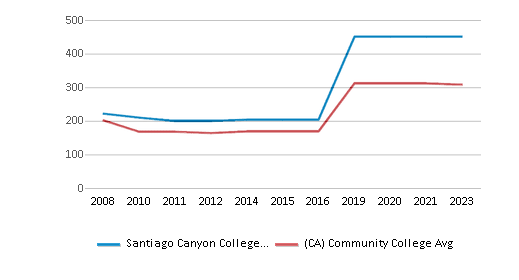
School Calendar
Student Body
The student population of Santiago Canyon College has grown by 55% over five years.
The student:teacher ratio of 41:1 has increased from 20:1 over five years.
The Santiago Canyon College diversity score of 0.61 is less than the state average of 0.70. The school's diversity has stayed relatively flat over five years.
Total Enrollment
18,473 students
2,311 students

Student : Teacher Ratio
41:1
32:1
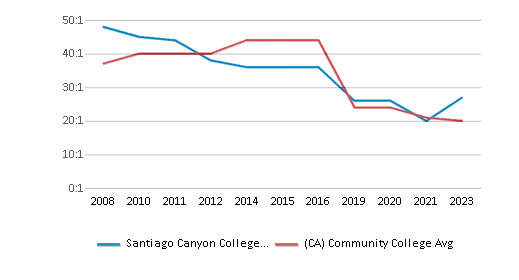
# Full-Time Students
5,213 students
1,232 students
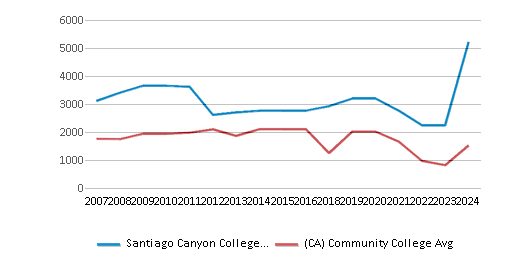
# Part-Time Students
13,260 students
8,299 students
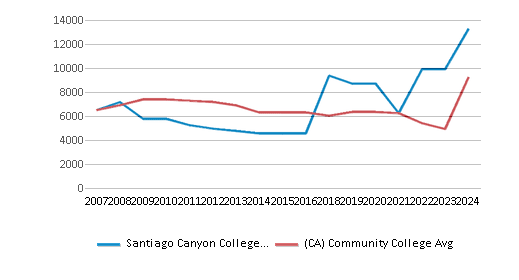
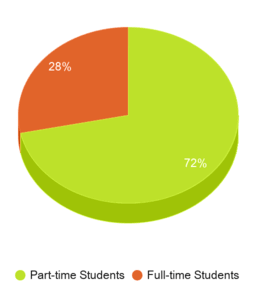
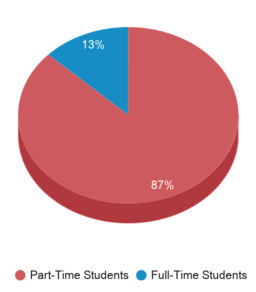
# Enrollment Undergraduate
184 students
240 students
# Full-Time Undergraduate Students
5,213 students
1,155 students
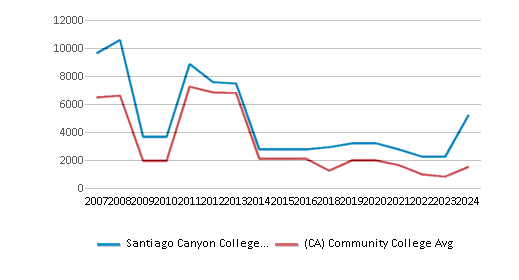
# Full-Time Graduate Students
n/a
63 students
# Part-Time Undergraduate Students
13,260 students
8,457 students
# Part-Time Graduate Students
n/a
10 students
Total Dormitory Capacity
n/a
140 students
% American Indian/Alaskan
n/a
n/a
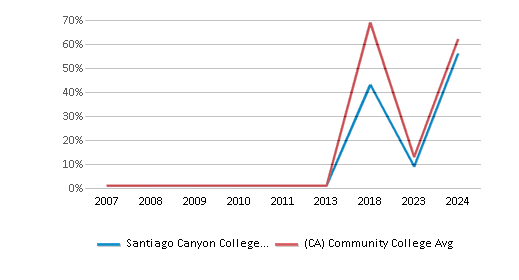
% Asian
8%
13%
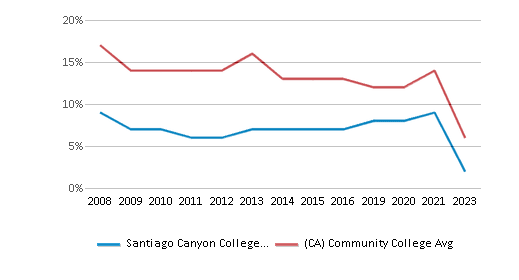
% Hispanic
56%
47%
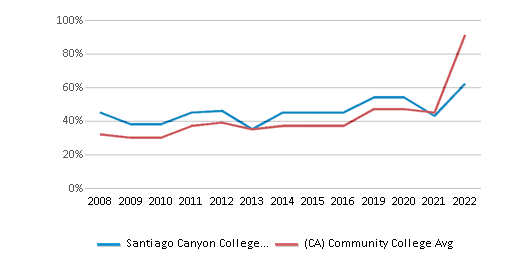
% Black
2%
7%
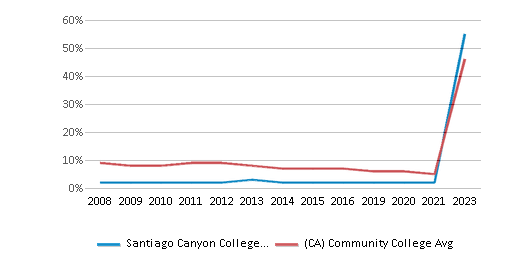
% White
26%
23%
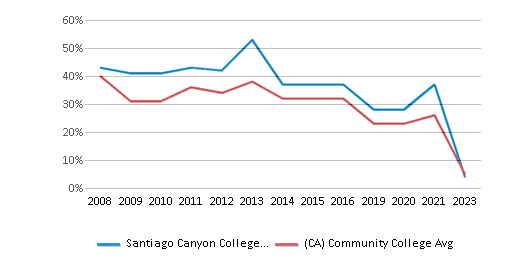
% Hawaiian
n/a
1%
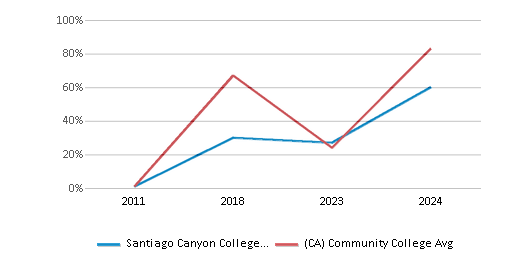
% Two or more races
4%
5%

% Non Resident races
1%
1%
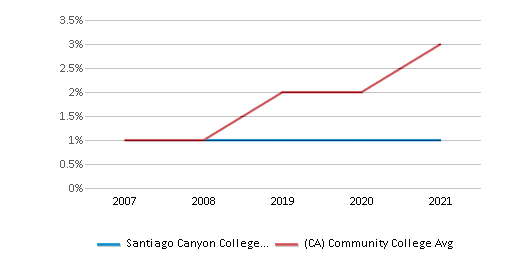
% Unknown races
2%
3%
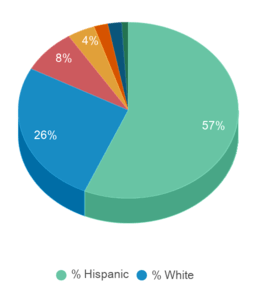
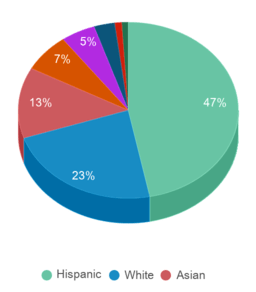
Diversity Score
0.61
0.70
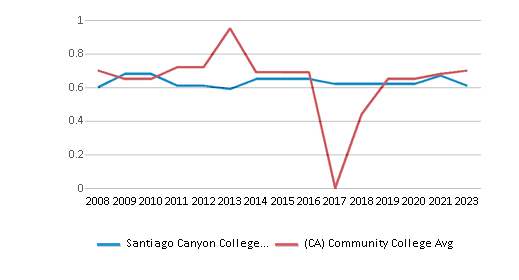
College Completion Rate (Students who graduate in less than 4 years)
0.4541%
0.4221%

College Completion Rate (Students who graduate in 4 years or more than 4 years)
n/a
0.4304%
Tuition and Acceptance Rate
The public in-state tuition of $1,142 is less than the state average of $1,236. The in-state tuition has stayed relatively flat over four years.
The public out-state tuition of $7,944 is more than the state average of $6,547. The out-state tuition has declined by 11% over four years.
In-State Tuition Fees
$1,142
$1,236
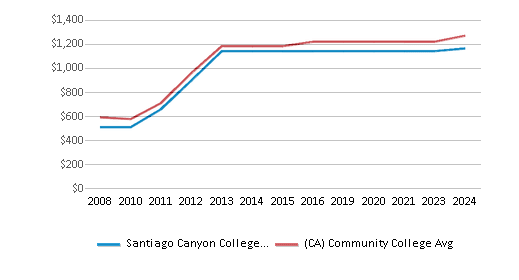
Out-State Tuition Fees
$7,944
$6,547

% Students Receiving Some Financial Aid
73%
85%
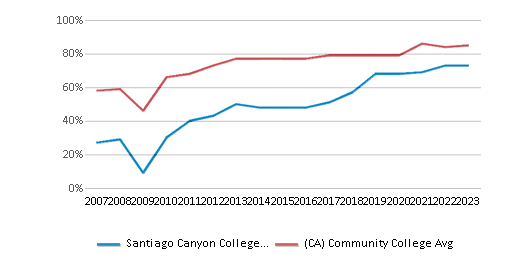
Median Debt for Graduates
$4,500
$10,500
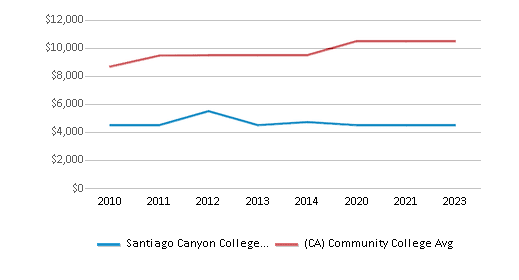
Median Debt for Dropouts
$4,500
$6,239
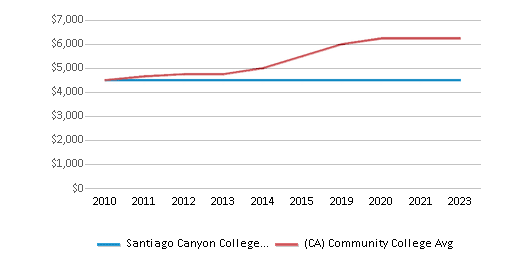
Acceptance Rate
n/a
92%
Sports
Total Sports Offered
7 sports
Sports
Basketball, Soccer, Softball, Swimming, Tennis, Volleyball, Water Polo
Extracurriculars
Total ExtracurricularsTotal Extra-curric.
1 extracurricular
ExtracurricularsExtra-curric.
Club or Organization:
International Student Club
International Student Club
Source: 2024 (or latest year available) Integrated Postsecondary Education Data System (IPEDS) , School Administrators
Frequently Asked Questions
How much does Santiago Canyon College cost?
Santiago Canyon College's tuition is approximately $1,142 for In-State students and $7,944 for Out-State students.
What sports does Santiago Canyon College offer?
Santiago Canyon College offers 7 interscholastic sports: Basketball, Soccer, Softball, Swimming, Tennis, Volleyball and Water Polo.
What is Santiago Canyon College's ranking?
Santiago Canyon College ranks among the top 20% of community college in California for: Largest student body and Least debt for graduating students.
Recent Articles

Obtaining Your Bachelor's Degree at a Community College
Explore the evolving landscape of community colleges offering bachelor's degrees, addressing affordability, accessibility, and workforce needs.

A to Z of Community College Certificates and Courses
From business and healthcare to technology and skilled trades, the article showcases the breadth of options available to students seeking to enhance their knowledge, develop new skills, or pursue career advancement.

What is a Community College?
This comprehensive guide explains what a community college is, its history, and its role in higher education. It covers the types of programs offered, differences from four-year colleges, benefits of attending, and important considerations for prospective students, providing valuable insights for those exploring educational options.










